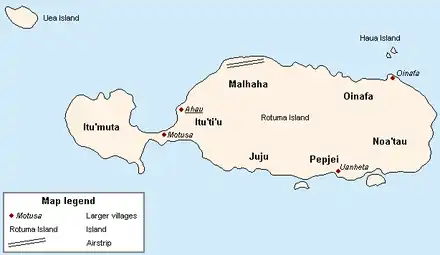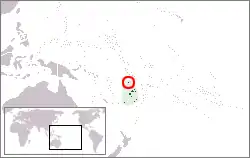 Schematic map of Rotuma Group (Solnohu is located at its southernmost point) | |
 Location of Solnohu in Polynesia | |
| Geography | |
|---|---|
| Location | South Pacific Ocean |
| Coordinates | 12°31′34″S 177°5′28″E / 12.52611°S 177.09111°E |
| Archipelago | Rotuma Group (16 islands inc. Rotuma) |
| Area | 9.6 ha (24 acres) |
| Highest elevation | 37 m (121 ft) |
| Administration | |
| Division | Eastern |
| Province | Rotuma |
| Demographics | |
| Population | 0 |
| Ethnic groups | Rotuman |
| Additional information | |
| Time zone | |
| • Summer (DST) |
|
Solnohu or Sol Nohu, also known as Solnoho, Solnahu and Solnahou, is a small crescent-shaped uninhabited island in the Rotuma Group of Fiji. The island is of special importance in Rotuman and Tongan funerary customs.[1]
Geography
Solnohu is the fourth largest island in the Rotuma Group of sixteen volcanic islands located 646 kilometres (401 mi) north of Fiji. It has an area of 9.6 hectares and lies approximately 70 meters away from the southern district of Juju on the main island of Rotuma, but it is still within the fringing reef. The island is also one of two outliers to the south of Rotuma, the other being Solkope.
Climate
The climate in the area is temperate. The average annual temperature is 20 °C. The warmest month is March, when the average temperature is 26 °C, and the coldest is December, with 0 °C.[2] The average annual rainfall is 3,420 millimeters. The wettest month is February, with an average of 504 mm of precipitation, and the driest is September, with 195 mm of precipitation.[3]
Flora and fauna
Some of the flora common to the island are the Epipremnum pinnatum, a species of flowering plant in the Araceae family[4] and the Merremia peltata, a species of flowering vine in the Convolvulaceae family.[5]
Solnohu is also part of the Rotuma Important Bird Area (IBA) which consists of the main island of Rotuma and associated small satellite islets.[6]
Mythology
One of the island's known legends is that of "The turtle of Sol Onau" (or Sol Onah, both being alternative spellings of Sol Nohu).[7] The legend tells of two girls who slip from a flat rock platform at the top of the island and fell to the sea. The girls did not die but were instead changed into two immortal sea turtles, one red and one white. They are said to live in the coral under the rock, and can be called up at any time by singing an incantation.
See also
References
- ↑ "Rotuman Custom as told to Gordon Macgregor in 1932 from notes archived at Bishop Museum, Honolulu, Hawai'i – Death: Graves(7)". Rotuma.net. Alan Howard and Jan Rensel. Archived from the original on 1 November 2013. Retrieved 9 April 2021.
- ↑ "NASA Earth Observations: Dataset Index". NASA.gov. NASA/NEO. Archived from the original on 1 June 2020. Retrieved 30 January 2016.
- ↑ "NASA Earth Observations: Rainfall (1 month – TRMM, 1998–2016)". NASA.gov. NASA/NEO/Tropical Rainfall Measuring Mission (TRMM). December 2014. Archived from the original on 11 May 2020. Retrieved 30 January 2016.
- ↑ "Consortium of Pacific Herbaria – Specimen Records – University of South Pacific (Fiji) (SUVA)". ASU.edu. Arizona State University. 5 November 1991. Archived from the original on 19 April 2021. Retrieved 4 April 2021.
- ↑ "Merremia peltata (Convolvulaceae) – herbarium voucher specimen from Rotuma Island (Fiji Islands/Fiji/Pacific region)". HEAR.org. Hawaiian Ecosystems at Risk project (HEAR). 1 October 2003. Archived from the original on 26 July 2008. Retrieved 4 April 2021.
- ↑ "Important Bird Areas factsheet: Rotuma". BirdLife.org. BirdLife International. 2018. Archived from the original on 26 June 2018. Retrieved 7 April 2021.
- ↑ "From J. Stanley Gardiner (1898), "The Natives of Rotuma," Journal of the Royal Anthropological Institute 27:503-518 – XXV. LEGENDS (f)". Hawaii.edu. University of Hawaiʻi. Archived from the original on 4 July 2017. Retrieved 10 April 2021.
External links
- Solnohu Island at Wikimapia
- Solnohu Island at GeoNames
- Solnohu Island at Geographic.org (with data from the U.S. National Geospatial-Intelligence Agency)
- Solnohu Island at WeatherHQ